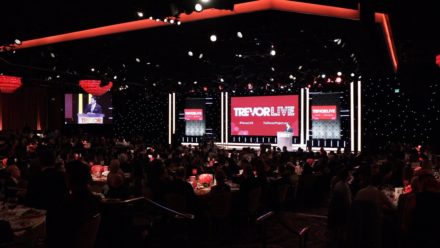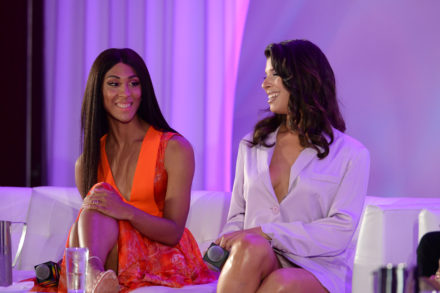Arts & Entertainment
Hayley Kiyoko and Kehlani fall in love in romantic ‘What I Need’ music video
The couple give into their feelings on a wild trip
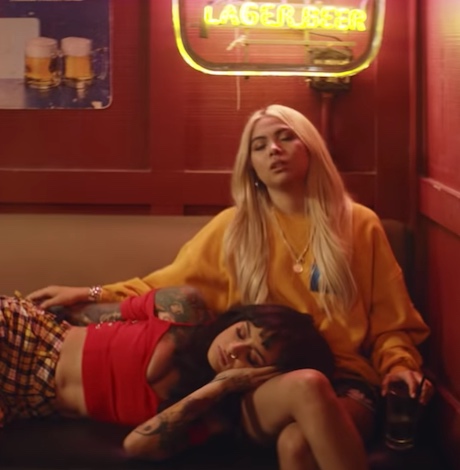
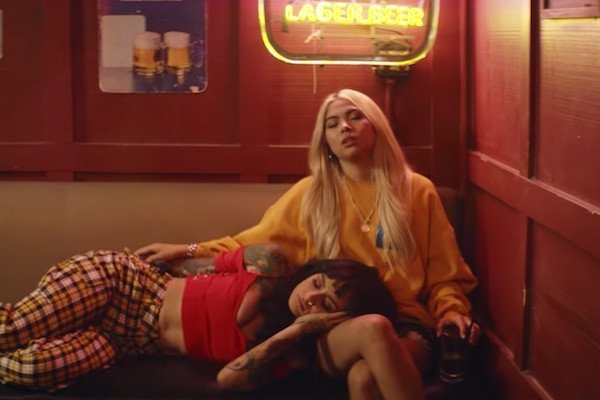
Kehlani and Hayley Kiyoko in ‘What I Need’ music video (Screenshot via YouTube)
Lesbian pop star Hayley Kiyoko and queer R&B singer Kehlani give into their feelings for each other during a road trip for the music video “What I Need.”
The video opens with Kehlani packing her bag and fighting with her aunt.
“You think I’m fucking stupid and I don’t know that that’s more than just a best friend?” her aunt yells at her.
“Can I be me? I’m my own fucking person, why does it always have to turn into [something] about her?” Kehlani responds before leaving the house and getting into Kiyoko’s car.
The pair drive around and go to a bar before their car breaks down on the road. A truck driver offers them a ride but Kiyoko doesn’t want to get in the car with him. Kehlani decides to go but decides to leave at the last minute. She runs into Kiyoko’s arms and the couple kiss.
“just so u know…. this my favorite video i’ve ever been apart of. Hayley is a genius, an incredible actress and one of the most diligent and hard working directors i’ve ever had the pleasure of working with. who’s ready? #WHATINEED,” Kehlani tweeted about the video.
just so u know…. this my favorite video i’ve ever been apart of. Hayley is a genius, an incredible actress and one of the most diligent and hard working directors i’ve ever had the pleasure of working with. who’s ready? #WHATINEED
— Kehlani (@Kehlani) May 30, 2018
Kiyoko responded, “I LOVE YOU KEHLANI.”
I LOVE YOU KEHLANI ??????
— Hayley Kiyoko (@HayleyKiyoko) May 30, 2018
“What I Need” will be featured on Kiyoko’s debut album “Expectations.”
Watch below.
Movies
Long-awaited ‘Pillion’ surpasses the sexy buzz
A film to admire from a promising new queer director

In case you didn’t know, “Pillion” – the title of debut UK filmmaker Harry Lighton’s buzzy gay “fetish rom-com” starring Scandinavian hunk Alexander Skarsgård and “Harry Potter” alumnus Harry Melling – refers to a rear seat on a motorcycle for a passenger, and the person who occupies it is said to be “riding pillion.”
That definition might be useful going into the movie’s story of an introverted gay Londoner who becomes involved with a handsome but icy biker and is introduced to the subculture of Dom/sub relationships, in that it evokes a dynamic that might be said to reflect the one that exists between its two main characters. There is nothing about Lighton’s disarmingly humorous and surprisingly sweet film, however, that seems to imply an interest in offering pat explanations or easy value judgments about the lifestyle it explores, so to think its title is meant as some kind of summation would be a mistake.
It centers on Colin (Melling), a timid parking warden who still lives with his mom and dad (Lesley Sharp and Douglas Hodge) and sings with a barbershop quartet as a hobby. After a gig singing Christmas carols at a gay bar, he catches the eye of sleekly confident Ray (Skarsgård), who gives him his phone number after a brief and thrillingly intimidating interaction. Prompted by his parents, he decides to call, leading to a steamy hookup in a back alley – and eventually, a live-in BDSM situation in which he becomes Ray’s official “sub,” catering to his every need and becoming a member of the gay biker community to which he belongs. It’s all perfectly fine with Colin, who embraces his role with pleasure; but when he begins to long for a deeper connection with the enigmatic and emotionally distant Ray, it triggers a disruption in the dynamic of their relationship, putting it to a test it may not be able to pass.
“Pillion” was already creating a stir before its prize-winning debut at the Cannes Film Festival last May, largely thanks to the highly publicized casting of Skarsgård as the leather-clad leading man in a gay BDSM romance. But near-universal critical acclaim quickly validated the buzz, turning it into one of 2025’s most anticipated movie releases – particularly, of course, for gay audiences, and especially for those who are part of the BDSM community and rarely get the opportunity to be “seen” on the screen as anything other than a lazy stereotype.
Naturally, much of that buzz has been driven by a prurient fervor, fueled by the promise of kinky onscreen sex and rumors of a notorious close-up highlighting the full-frontal assets of a certain Swedish movie star. One of the things that’s remarkable about “Pillion,” however, is that while it certainly doesn’t downplay the overt sexual aspect of the relationship at its center, it doesn’t use them to titillate or shock us. Its plentiful scenes of intimacy are sexy, yes, but they also chart the development of the characters’ bond together, expressing feelings that can only be left unspoken within their agreed-on dynamic. They advance both the story and our awareness of the characters’ psychology, and while they may occasionally provide a jolt for viewers not accustomed to seeing gay fetish sex portrayed explicitly on screen, they successfully capture the joy of the experience instead of making it feel sensationalized or lurid.
In fact, once “Pillion” ends, it’s not the sex (not exclusively, at least) that lingers in our mind; it’s the delicate balance it maintains between tension and ease, detachment and tenderness, rigidity and flow – mirroring the surging passions contained within the strictly regimented order of their power dynamic. It’s the depth of Melling’s film-anchoring performance, in which he undergoes an entire voyage of discovery that emphasizes Colin’s strength, not his timidity, and allows us to relate to him in ways that may surprise us. It’s the authenticity of the relationships between all the characters, from Sharp and Hodge’s doting parents to Scissor Sisters front man Jake Shears (in his film acting debut) as a fellow sub who ignites a spark of jealousy between Colin and Ray; most of all, it’s the way that it allows the story to move, with a slow and methodical rhythm – reflected in the measured strains of Eric Satie’s “Gymnopode No.1” that echo through Oliver Coates’ evocative score – that makes it all feel perfectly natural.
And yes, it’s also the presence of Skarsgård, who subtly (and with wry humor) contrasts tight-lipped alpha stoicism with his flawless male beauty that feels like a force of nature. We don’t know much about Ray, ever, through the dialogue in Lighton’s tersely worded screenplay, but we can draw our own conclusions from the eloquent silence that Skarsgård wraps around the character like a security blanket. Best of all, he never uses his “Dom” role in the film to overshadow Melling – it’s Colin’s story, after all, and Skarsgård’s Ray deploys a tactic of “quiet command” on him throughout without ever stealing his spotlight.
As for the film’s writer/director, Lighton manages perhaps the most delicate balancing act of all. He takes a story (adapted from a novel by Adam Mars-Jones) about someone discovering himself in the BDSM community, who engages in sexual behavior that’s likely out of the comfort zone of many viewers and enters a “romantic” partnership most people would find unacceptable, and turns it into a movie that is all about the complexities of human experience. You may not know much (or want to) about life as a sub in a BDSM partnership, but you know what it feels like to love someone, and to long for love in return; Lighton understands that “Pillion” is a story about that, and he knows how to tell it so that you will understand it, too.
That said, it’s obvious there will be many audiences out there for whom a movie about leather-clad queer fetish sex might simply be a step too far for them to take. Anyone approaching “Pillion” should be aware that, depending on your own level of familiarity – or comfort – with the BDSM lifestyle, your reaction may be vary across a spectrum of perspectives; if you’ve been around it, nothing the movie shows you is likely to ruffle your feathers, and if you haven’t, well, only you know your limits.
For us, it’s a film to admire from a promising new queer director, shining a light on an insular culture within the larger rainbow community with intelligence, dignity, and a refreshing lack of the homophobic tropes that so often haunt queer movies, when they are made by queer filmmakers themselves.
Unfortunately for Americans, while “Pillion” was released in the UK on Nov. 28, we won’t get a chance to see it until Feb. 6. With the buzz now even stronger and the stars in full “promotional” mode on the talk show circuit, we thought it would be a good idea to let you know that the wait might still be a while, but it will be worth it.
After all, as any good Dom can tell you, a pleasure withheld tastes even sweeter when it’s finally given.
a&e features
Indya Moore on history-making Gotham Award nomination and speaking out on social media: “It has complicated my access to work”
The Pose star also recalls first stepping into the role of Angel during Trump’s presidency
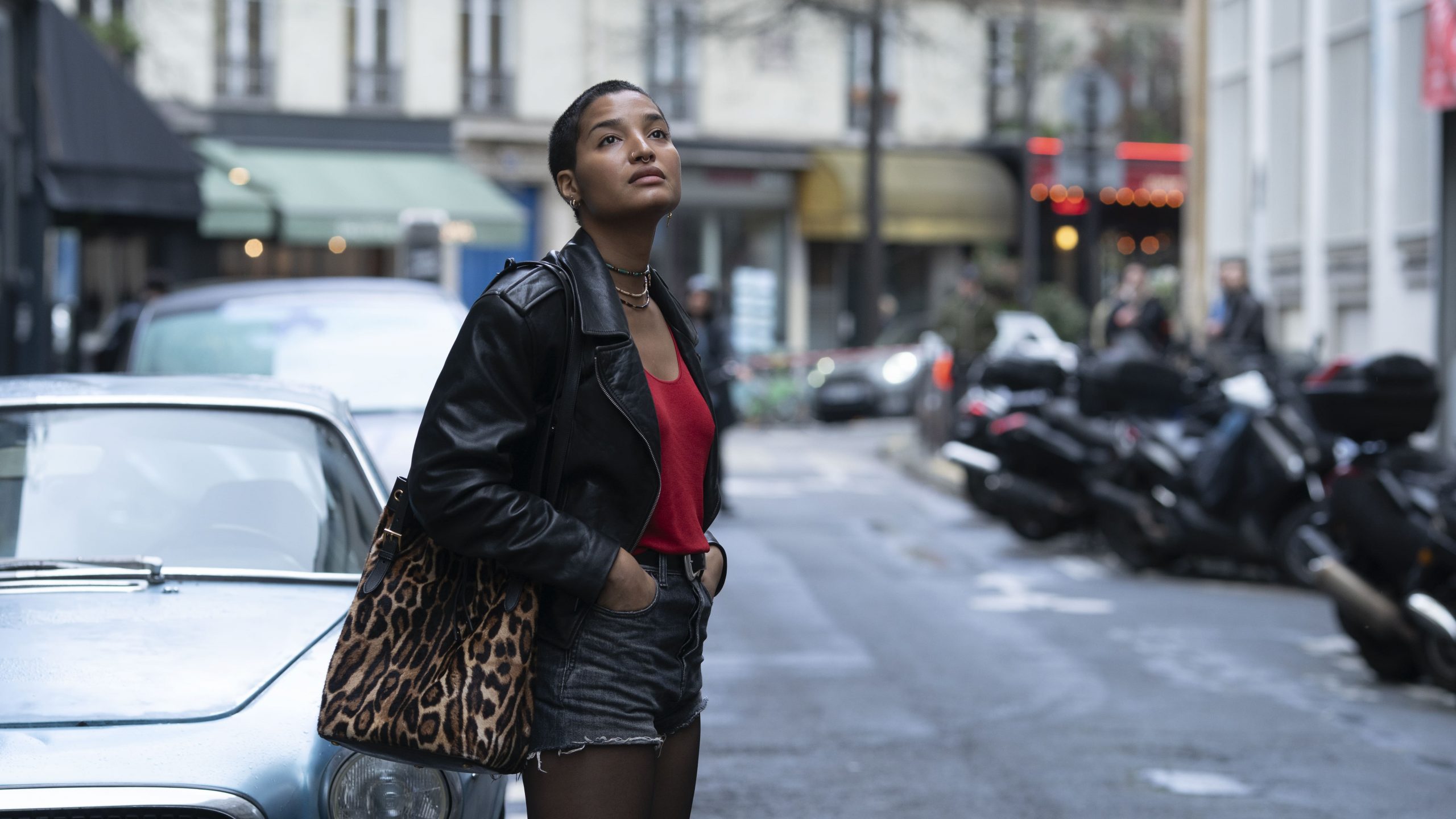
Since their breakthrough role in Ryan Murphy’s Pose, Indya Moore has been no stranger to making history both on the big screen and off it. Most recently, they became the first openly trans or non-binary actor to be nominated at the Gotham Awards in the lead or supporting categories.
“It happened because I had the opportunity,” Moore says of being recognized for their work in Jim Jarmusch’s newest indie, Father Mother Sister Brother. “It’s hard for me to receive the award of a nomination, but I really do appreciate it. It makes me feel like I’m growing in the right direction. It’s a very positive nod to keep working the way I did for this film.”
Jarmusch’s Father Mother Sister Brother, which won the top award at this year’s Venice Film Festival and is being distributed in the U.S. by MUBI (who released The Substance last year), is divided into three distinct chapters, exploring dysfunctional family dynamics. Moore appears in the last chapter, titled Sister Brother, alongside Luka Sabbat. The two play twins who reunite following the death of their parents, and must figure out how to move forward in their lives. The previous chapters feature Cate Blanchett, Adam Driver, Charlotte Rampling, Tom Waits, and Vicky Krieps.
Ahead of the film’s Christmas Eve release, Moore spoke with The Blade about working with Jarmusch for the first time on Father Mother Sister Brother, making history at the Gotham Awards, and why they remain active on social media and speak out about worldwide issues despite it complicating their “access to work.” This interview has been edited and condensed.
This film is your first with Jim Jarmusch. I’m curious how familiar you were with his work before, and how you got involved with the film?
I received an email about it, and then we spoke about it on the phone. It was really beautiful to be imagined as Skye and envisioned in the life of a character who is experiencing an aspect of being alive and being human that isn’t about persecution or hurt. I thought that was beautiful. These are the sorts of tones that I appreciate working with, the depths I always hope to find in this work. And I found that with Jim. I’m grateful it was him and that he chose me. I don’t know if it was even a choice for him because the way that he describes it is that these characters existed in his mind as me and Luka [Sabbat].
You appear after the first two chapters (titled Father and Mother), and the relationships between the characters there are much more strained and awkward, often comedically so. I love the tenderness Skye has with Billy in that final chapter. Could you speak to how the sibling relationship ties thematically into the film overall?
There is an interesting dynamic where it seems like the characters are different versions of each other — the parents and the siblings. And in each vignette, Skye is probably a mixture of all the previous siblings. And Billy is like the previous brother in a way. And also, the masking that the other characters seem to do is why the relationships all feel strained. They’re all hiding from each other, but they all love each other at the same time. They still all want to be there with each other, and it’s a really beautiful tension.
In the relationship between my character and Billy, there is more comfort in being together and seeing each other again — a gleefulness and joy that comes with being reunited. But the circumstances it happens with are overwhelmed with grief. Their relationship doesn’t seem that they’re masking. Like we see that Billy is experimenting with mushrooms, and so is Skye. The very nature of these medicines is to unmask. And so it’s a different perspective on what’s possible when people love and accept each other for who they are.
That’s really beautifully said. I don’t know if this is an explicitly queer film, but I think queer people might find unique connections with the dysfunctional family dynamics and how difficult that can be. As an openly queer person, are there ways you were able to specifically tap into some of the themes?
I think it’s very reflective of family dysfunction. Whether your kid is queer or just different in some funky, wacky way — kind of like Vicky Krieps’ character was. There’s always something about a person that others justify being cruel to and dominating, especially in sibling relationships. It’s really messed up. When we don’t learn to do that as kids with each other as siblings, we do that to each other as adults and become really oppressive people. We don’t understand other people’s autonomy and dignity, and it turns into all kinds of mistreatment and potentially persecution if you become somebody in a position of power and authority. Family is a really powerful opportunity for us to figure out who we’re going to be out in the world. We’re born to strangers, we’re born to random people, and end up having random siblings.
When you request that someone present their authentic self, you trust and believe them when they do. That should be synonymous with believing people when they tell you they’re queer, or they have a disability that they need to make boundaries around. Or if they’re a person of color, they come from a history of intergenerational trauma and persecution and genocide. How do you respond to that? Or someone else who may be part of a people who are being occupied and colonized right now. Without all these fancy political words, how do we empathize with people who are trying to survive cruelty? How do we find the wisdom and incentive to love people when you get nothing back in return for doing it? That is what the advancement and hard work actually is. In Father Mother Sister Brother, the narrative doesn’t get that deep, but it evokes that train of thought. It evokes that framework of thinking about relationships, and I appreciate the film for doing that.

This film won the Golden Lion at this year’s Venice Film Festival, and you recently made history at the Gotham Awards as the first openly trans nominee in the supporting or lead acting categories (Jack Haven was nominated for I Saw the TV Glow before they came out). What does that recognition mean to you?
Oh, well, that’s news to me. I didn’t know that I was the first trans nominee. I appreciate that acknowledgement. It happened because I had the opportunity. I don’t know how to think about it. It’s hard for me to receive the nomination, but I really do appreciate it. It makes me feel like I’m growing in the right direction. It’s a very positive nod to keep working the way I did for this film.
This year, you were also featured in Ponyboi, a great indie film that was notable for having a lead intersex character. What was your experience on that film? I wish it were getting more attention.
River Gallo is one of the most beloved people in my life. I love them so much, and I’m so proud. They wrote the film, sent it out, and got it made. That is phenomenal to me. They’re so brilliant, so loving, kind, generous, funny. Funny, oh my god! I had so much fun working with them. It was really fun to step into the complexity of my character, Charlie. She brought a meanness that does exist in some subcultures of the trans community. I loved supporting River and telling this story.
Talking about the state of the queer community and the world we’re living in, you have used social media as a real platform. Not just with what’s happening in the U.S., but Palestine and so many other issues. How do you approach using social media, especially as you’re getting more accolades and awards attention?
I know that it has complicated my access to work. It’s not incentivizing to go against the grain of this political suffocation that is taking everybody — children, women, trans and queer people, brown people, indigenous folks, and so many folks all over the world. There is an ushering in of some new world, some order that seems to be leaving behind a lot of suffering. Insurmountable suffering that we’ve never seen before. Nothing good comes out of that. Nothing good comes out of that ever. Nothing good comes out of separating people’s families. Nothing good comes out of lying to justify the exercise of power to do that. To cause suffering and terror, and then to call people who ask and demand for it to stop “terrorists.” I never imagined that we would live in a time where unarmed civilians are being called “terrorists” and are not allowed to fight against people who are hurting them, who are taking their homes and shelter and land, who are refusing to give up their only homes. Just for refusing to go homeless so that other people can have multiple homes and more wealth. What the fuck is that shit? Excuse my language. In the name of God, what are we looking at?
I stepped into the role of Angel in Pose during Donald Trump’s presidency [in 2018]. I have not had an opportunity to just be an artist who isn’t also having to take the extra step in engaging my audience that is unaffected with my audience that is. That is what my work has been. That is what I think the role of an artist is — to engage people with other people through your work. However, that instrument manifests as, be it a voice, a platform, or a creative medium. Being trans, being a person of color, and also feeling the weight of responsibility is deep work. And also being human. I have to use my platform to be a reminder of principles of how to treat each other, and also make sure that I’m maintaining that in my own life. And that’s hard. I’ve made mistakes too. When you have a platform, people romanticize you as a better version of themselves. They idolize you. So I’m constantly telling people to stop calling me a goddess. I’m not a queen. I’m a person just like you.
Truly, empathy is evolutionary, and we cannot replace it with machines. It’s not going to work, and we keep trying. And that’s why I’m trying to use my platform the best way that I can. I haven’t been as creative in my messaging; I’ve just been very direct and straight to it. I’m not even necessarily trying to be the voice for everything, but also sharing other people’s. But it’s exhausting. And now to be under the pressure of the anti-trans and anti-free speech stuff that is happening. If you don’t have a platform, you have a life. And that’s enough.
a&e features
Allison Reese’s advice? Take your comedic medicine.
Influencer, writer, comedian, and producer Allison Reese talks about the power of comedy, the news cycle, and her relationship with Kamala Harris.

It’s often said that laughter is the best medicine. Comedian, writer, and producer Allison Reese reflects this as she has been helping her audience cope with the news cycle for years by doing various impressions of Kamala Harris on social media (which have received over 6 million likes on TikTok), through her past experiences on late-night television, and her stage appearances.
Allison has seen the positive impact of her videos and reflected on why she felt like so many people, especially those in the queer community, resonated with them. Allison shared with the Blade, “I like to think of it if I’m doing my Kamala impression, it’s like Kamala drag almost. It’s not so much just a character I do.”
Satire is something that many are using not only to digest the world around them, but it has also become a way for many to digest their news. Some people feel that the Last Week Tonight show is journalism despite John Oliver saying otherwise.
Allison stated, “As a comedian, it’s chemistry in a way. It’s like you have to have sugar to help the medicine go down, but you have to calculate how much sugar to how much medicine. Sometimes you need more medicine and a little bit of sugar. Sometimes you need a lot of sugar, because the medicine is so tough to swallow.”
While late-night shows still continue to pull in viewers, the dynamic of who people are listening to and watching is changing.
Late night is dominated by straight white men, with the exception of The Daily Show. Within the last year, late night programming has faced uncertainty with shows either being canceled or pulled off the air for a period of time.
The demand for more short-form content will continue to grow.
Allison shared, “I think the future of late night is going to be on social media. I think it’s not going to be peddled by these monolithic corporations to say, ‘Oh, you’re the right type of white guy to give me my jokey news’, you know?”
However, regardless of what the future holds, people will most likely find ways to remain optimistic when faced with tough information.
Allison understands this. Before moving to LA, she lived in New York during the middle of the pandemic and experienced the process of watching the city revive itself. “It ended up being really lovely doing stuff there as that city kind of woke up.”
One way that Allison plans on continuing to make us laugh is through releasing her new mockumentary-style web series, LGBT IDK, coming out in 2026.
Allison stated, “It follows me as I navigate the chaos of queer dating after a divorce. It’s fully improvised, and I am set up on these blind dates by my friend. And I get to date, and it’s just me with somebody who’s playing a larger-than-life comedic character.”
You can find it on her YouTube channel.
Books
‘Dogs of Venice’ looks at love lost and rediscovered
A solo holiday trip to Italy takes unexpected turn

‘The Dogs of Venice’
By Steven Crowley
c.2025, G.P. Putnam & Sons
$20/65 pages
One person.
Two, 12, 20, you can still feel alone in a crowded room if it’s a place you don’t want to be. People say, though, that that’s no way to do the holidays; you’re supposed to Make Merry, even when your heart’s not in it. You’re supposed to feel happy, no matter what – even when, as in “The Dogs of Venice” by Steven Rowley, the Christmas tinsel seems tarnished.

Right up until the plane door closed, Paul held hope that Darren would decide to come on the vacation they’d planned for and saved for, for months.
Alas, Darren was a no-show, which was not really a surprise. Three weeks before the departure, he’d announced that their marriage wasn’t working for him anymore, and that he wanted a divorce. Paul had said he was going on the vacation anyhow. Why waste a perfectly good flight, or an already-booked B&B? He was going to Venice.
Darren just rolled his eyes.
Was that a metaphor for their entire marriage? Darren had always accused Paul of wanting too much. He indicated now that he felt stifled. Still, Darren’s unhappiness hit Paul broadside and so there was Paul, alone in a romantic Italian city, fighting with an espresso machine in a loft owned by someone who looked like a frozen-food spokeswoman.
He couldn’t speak or understand Italian very well. He didn’t know his way around, and he got lost often. But he felt anchored by a dog.
The dog – he liked to call it his dog – was a random stray, like so many others wandering around Venice unleashed, but this dog’s confidence and insouciant manner inspired Paul. If a dog could be like that, well, why couldn’t he?
He knew he wasn’t unlovable but solo holidays stunk and he hated his situation. Maybe the dog had a lesson to teach him: could you live a wonderful life without someone to watch out for, pet, and care for you?
Pick up “The Dogs of Venice,” and you might think to yourself that it won’t take long to read. At under 100 pages, you’d be right – which just gives you time to turn around and read it again. Because you’ll want to.
In the same way that you poke your tongue at a sore tooth, author Steven Rowley makes you want to remember what it’s like to be the victim of a dead romance. You can do it here safely because you simply know that Paul is too nice for it to last too long. No spoilers, though, except to say that this novel is about love – gone, resurrected, misdirected – and it unfolds in exactly the way you hope it will. All in a neat evening’s worth of reading. Perfect.
One thing to note: the Christmas setting is incidental and could just as well be any season, which means that this book is timely, no matter when you want it. So grab “The Dogs of Venice,” enjoy it twice with your book group, with your love, or read it alone.
The Blade may receive commissions from qualifying purchases made via this post.
Sports
LA County contributes over $181K to Out Athlete Fund for Pride House LA/West Hollywood
Pride House LA/West Hollywood is coming to L.A. County during the FIFA World Cup, 2028 Olympics, & more
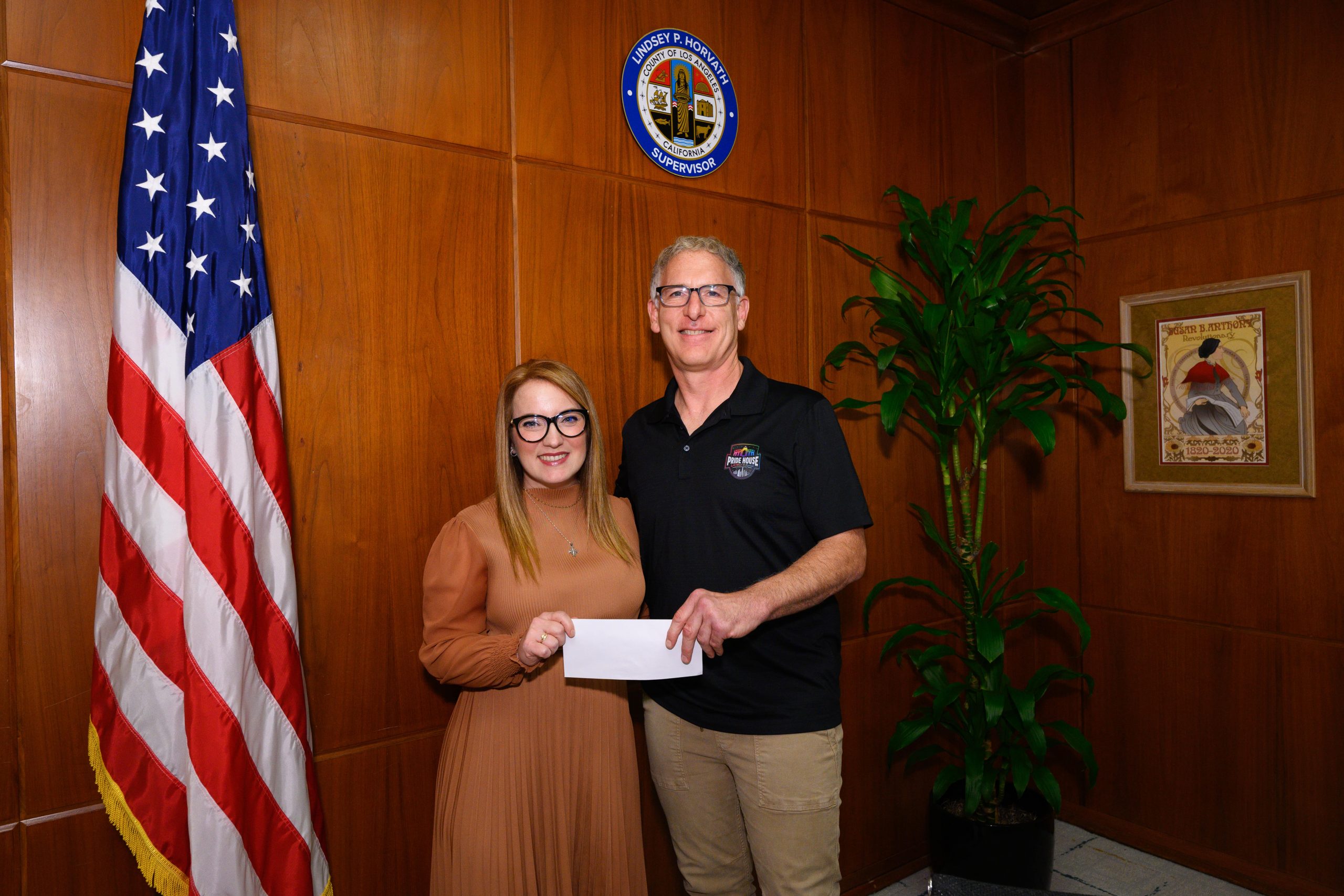
Hot off the heels of West Hollywood’s $1 million commitment to Pride House LA/West Hollywood, powered by the Out Athlete Fund, the County of Los Angeles has made a contribution of $181,200 for the development and production of events during the 2026 FIFA World Cup, the 2028 Summer Olympics and Paralympics, as well as other events throughout Los Angeles.
Pride House LA/West Hollywood will serve as the safe space and destination, transforming West Hollywood Park and the surrounding areas, set up to welcome LGBTQ+ fans, coaches, media, and athletes to the county. Pride House will present a series of events, including a highlight of the history of queer folk in sports, entertainment, and educational opportunities for the LGBTQ+ community, and outreach to allies celebrating the community.
Pride House LA/West Hollywood CEO Michael Ferrera shares, “Having support for Pride House from Los Angeles County Supervisor Lyndsey Horvath and people from across the County is a huge step toward delivering truly special experiences for the LGBTQ+ community at these
major sporting events here in Los Angeles.”
Los Angeles County Supervisor Lindsey P. Horvath remarked, “I am proud to support Pride House Los Angeles/West Hollywood as we prepare for the 2028 Games and work to ensure LGBTQ+ athletes are seen, supported, and celebrated at every level of sport. By expanding visibility, inclusion, and belonging, Pride House is strengthening both athletes and the broader sports community. Through its programming and community engagement leading up to 2028, we are helping build a lasting legacy of opportunity, representation, and support that extends well beyond the Games.”
The Out Athlete Fund is a non-profit organization committed to supporting out LGBTQ+ athletes on their journey to the Olympics and other national and international competitions. To donate and become a Founding Team Member, visit https://www.pridehouselaweho.org/donate.
Pride House LA/West Hollywood will take place in West Hollywood during the 2026 FIFA World Cup, June 11-14, and in West Hollywood Park, as well as select locations around Los Angeles County during the 2028 Los Angeles Summer Olympics, July 14-30, 2028.
The Los Angeles Blade serves as a proud media partner of Pride House/LA West Hollywood.
Events
Los Angeles Blade and matchmaker Daniel Cooley present a free gay holiday singles mixer

Happy Holidays!
We are feeling extra festive this season. To show our gratitude for this amazing community, we are gifting you something special…
We’ve partnered with our resident matchmaker, Daniel Cooley, from Best Man Matchmaking, to throw one of our biggest holiday parties of the year as we close out 2025!
Hosted by Koaty & Sumner Blayne, and featuring Steven Dehler as our very sexy Santa, get ready to make your Christmas wishes known on Tuesday, December 23rd, from 6–9 PM at The Abbey in West Hollywood, California
Expect playful icebreakers, festive flirting, handsome men, and — yes, you read that right — a FREE Singles Mixer. Our first ever! Consider it a holiday gift from us to the community.
Come mingle, sip, laugh, and maybe meet your holiday crush.
Celebrity News
Rob Reiner, ‘The Princess Bride’ director and outspoken LGBTQ+ ally, dies at 78
Reiner and his wife advocated against California’s same-sex marriage ban and spoke out for queer equality
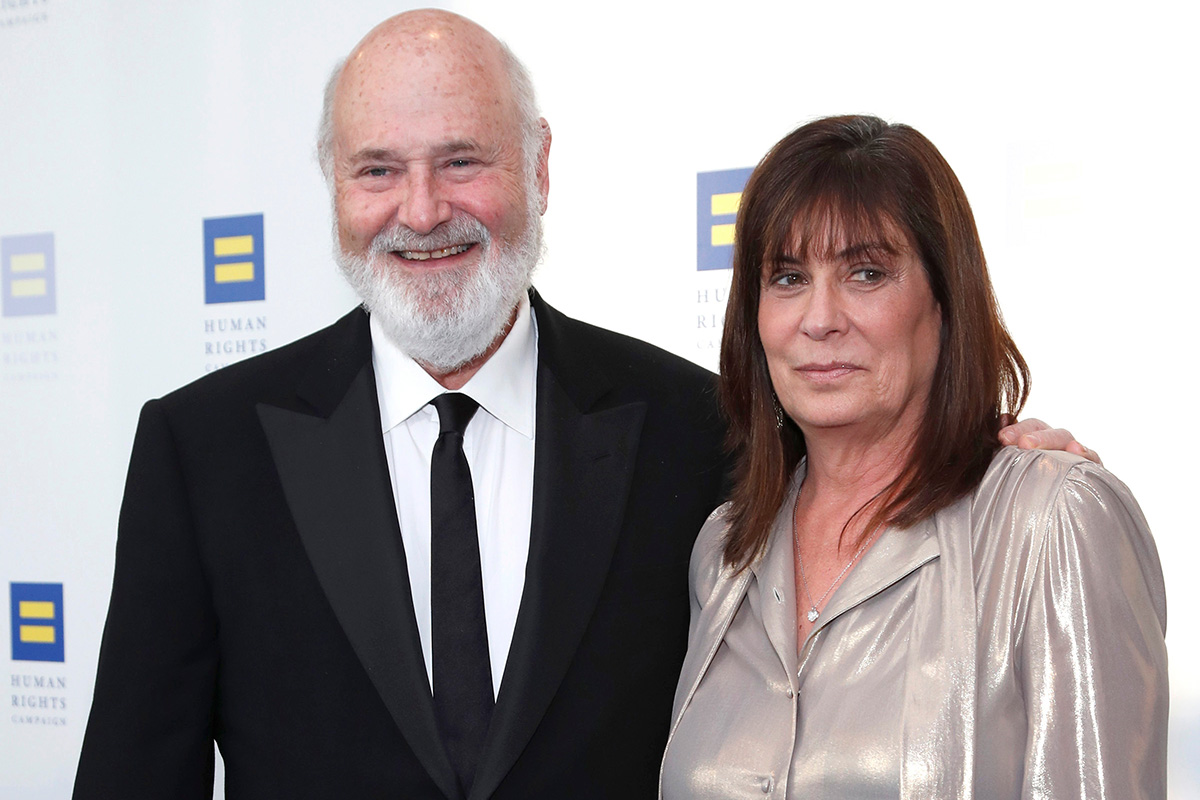
Rob Reiner, most known for directing untouchable classics like The Princess Bride, Misery, When Harry Met Sally…, and Stand by Me, died Dec. 14 alongside his wife, Michele Singer Reiner, in their Los Angeles residence. While investigations are actively underway, sources have told PEOPLE Magazine that the pair’s son, Nick Reiner, killed his parents and has been taken into custody.
Reiner was a master of every genre, from the romantic comedy to the psychological thriller to the coming-of-age buddy movie. But in addition to his renowned work that made him a household name, Reiner is also remembered as a true advocate for the LGBTQ+ community. In 2009, Reiner and his wife co-founded the American Foundation for Equal Rights, helping fight against California’s Prop 8 same-sex marriage ban. They were honored at the 2015 Human Rights Campaign Las Vegas Gala.
In a statement, HRC president Kelley Robinson said: “The entire HRC family is devastated by the loss of Rob and Michele Reiner. Rob is nothing short of a legend–his television shows and films are a part of our American history and will continue to bring joy to millions of people across the world. Yet for all his accomplishments in Hollywood, Rob and Michele will most be remembered for their gigantic hearts, and their fierce support for the causes they believed in–including LGBTQ+ equality. So many in our movement remember how Rob and Michele organized their peers, brought strategists and lawyers together, and helped power landmark Supreme Court decisions that made marriage equality the law of the land–and they remained committed to the cause until their final days. The world is a darker place this morning without Rob and Michele–may they rest in power.”
Reiner’s frequent collaborators have also spoken out as the industry is in mourning, including figures like Ron Howard and John Cusack.
A joint statement from Jamie Lee Curtis and Christopher Guest (who starred in Reiner’s This is Spinal Tap) reads: “Christopher and I are numb and sad and shocked about the violent, tragic deaths of our dear friends Rob and Michelle Singer Reiner and our ONLY focus and care right now is for their children and immediate families and we will offer all support possible to help them. There will be plenty of time later to discuss the creative lives we shared and the great political and social impact they both had on the entertainment industry, early childhood development, the fight for gay marriage, and their global care for a world in crisis. We have lost great friends. Please give us time to grieve.”
While attending the 2019 HRC Los Angeles Dinner, Reiner spoke out about the need for equality: “We have to move past singling out transgender, LGBTQ, black, white, Jewish, Muslim, Latino. We have to get way past that and start accepting the idea that we’re all human beings. We’re all human beings, we all share the same planet, and we should all have the same rights, period. It’s no more complicated than that.”

Santa will be very relieved.
You’ve taken most of the burden off him by making a list and checking it twice on his behalf. The gift-buying in your house is almost done – except for those few people who are just so darn hard to buy for. So what do you give to the person who has (almost) everything? You give them a good book, like maybe one of these.
Memoir and biography
The person who loves digging into a multi-level memoir will be happy unwrapping “Blessings and Disasters: A Story of Alabama” by Alexis Okeowo (Henry Holt). It’s a memoir about growing up Black in what was once practically ground zero for the Confederacy. It’s about inequality, it busts stereotypes, and yet it still oozes love of place. You can’t go wrong if you wrap it up with “Queen Mother: Black Nationalism, Reparations, and the Untold Story of Audley Moore” by Ashley D. Farmer (Pantheon). It’s a chunky book with a memoir with meaning and plenty of thought.
For the giftee on your list who loves to laugh, wrap up “In My Remaining Years” by Jean Grae (Flatiron Books). It’s part memoir, part comedy, a look back at the late-last-century, part how-did-you-get-to-middle-age-already? and all fun. Wrap it up with “Here We Go: Lessons for Living Fearlessly from Two Traveling Nanas” by Eleanor Hamby and Dr. Sandra Hazellip with Elisa Petrini (Viking). It’s about the adventures of two 80-something best friends who seize life by the horns – something your giftee should do, too.
If there’ll be someone at your holiday table who’s finally coming home this year, wrap up “How I Found Myself in the Midwest” by Steve Grove (Simon & Schuster). It’s the story of a Silicon Valley worker who gives up his job and moves with his family to Minnesota, which was once home to him. That was around the time the pandemic hit, George Floyd was murdered, and life in general had been thrown into chaos. How does someone reconcile what was with what is now? Pair it with “Homestand: Small Town Baseball and the Fight for the Soul of America” by Will Bardenwerper (Doubleday). It’s set in New York and but isn’t that small-town feel universal, no matter where it comes from?
Won’t the adventurer on your list be happy when they unwrap “I Live Underwater” by Max Gene Nohl (University of Wisconsin Press)? They will, when they realize that this book is by a former deep-sea diver, treasure hunter, and all-around daredevil who changed the way we look for things under water. Nohl died more than 60 years ago, but his never-before-published memoir is fresh and relevant and will be a fun read for the right person.
If celeb bios are your giftee’s thing, then look for “The Luckiest” by Kelly Cervantes (BenBella Books). It’s the Midwest-to-New-York-City story of an actress and her life, her marriage, and what she did when tragedy hit. Filled with grace, it’s a winner.
Your music lover won’t want to open any other gifts if you give “Only God Can Judge Me: The Many Lives of Tupac Shakur” by Jeff Pearlman (Mariner Books). It’s the story of the life, death, and everything in-between about this iconic performer, including the mythology that he left behind. Has it been three decades since Tupac died? It has, but your music lover never forgets. Wrap it up with “Point Blank (Quick Studies)” by Bob Dylan, text by Eddie Gorodetsky, Lucy Sante, and Jackie Hamilton (Simon & Schuster), a book of Dylan’s drawings and artwork. This is a very nice coffee-table size book that will be absolutely perfect for fans of the great singer and for folks who love art.
For the giftee who’s concerned with their fellow man, “The Lost and the Found: A True Story of Homelessness, Found Family and Second Chances” by Kevin Fagan (One Signal / Atria) may be the book to give. It’s a story of two “unhoused” people in San Francisco, one of the country’s wealthiest cities, and their struggles. There’s hope in this book, but also trouble and your giftee will love it.
For the person on your list who suffered loss this year, give “Pine Melody” by Stacey Meadows (Independently Published), a memoir of loss, grief, and healing while remembering the person gone.
LGBTQ fiction
For the mystery lover who wants something different, try “Crime Ink: Iconic,” edited by John Copenhaver and Salem West (Bywater Books), a collection of short stories inspired by “queer legends” and allies you know. Psychological thrillers, creepy crime, cozies, they’re here.
Novel lovers will want to curl up this winter with “Middle Spoon” by Alejandro Varela (Viking), a book about a man who appears to have it all, until his heart is broken and the fix for it is one he doesn’t quite understand and neither does anyone he loves.
LGBTQ studies – nonfiction
For the young man who’s struggling with issues of gender, “Before They Were Men” by Jacob Tobia (Harmony Books) might be a good gift this year. These essays on manhood in today’s world works to widen our conversations on the role politics and feminism play in understanding masculinity and how it’s time we open our minds.
If there’s someone on your gift list who had a tough growing-up (didn’t we all?), then wrap up “I’m Prancing as Fast as I Can” by Jon Kinnally (Permuted Press / Simon & Schuster). Kinnally was once an awkward kid but he grew up to be a writer for TV shows you’ll recognize. You can’t go wrong gifting a story like that. Better idea: wrap it up with “So Gay for You: Friendship, Found Family, & The Show That Started It All” by Leisha Hailey & Kate Moennig (St. Martin’s Press), a book about a little TV show that launched a BFF-ship.
Who doesn’t have a giftee who loves music? You sure do, so wrap up “The Secret Public: How Music Moved Queer Culture from the Margins to the Mainstream” by Jon Savage (Liveright). Nobody has to tell your giftee that queer folk left their mark on music, but they’ll love reading the stories in this book and knowing what they didn’t know.
The Blade may receive commissions from qualifying purchases made via this post.
Music & Concerts
Salina EsTitties and GMCLA are primed and ready for this weekend’s ‘Holiday Legends’
The fabulous Gay Men’s Chorus of Los Angeles reminds us there’s power in queer joy in this weekend’s holiday concert

Let’s face it, we could all use a little fellowship and joy this holiday season. Always here to save the day, the Gay Men’s Chorus of Los Angeles has yet another stellar concert to remind us that there is power in queer joy.
This holiday show, titled Holiday Legends, will pay homage to the season’s most
cherished songs, from traditional choral classics and pop Christmas anthems to Hanukkah
favorites. The show will feature the usual suspects – Santa, the Grinch, Rudolph, and more through the GMCLA’s take on old classics like White Christmas, Santa Baby, and Santa Claus Is Coming to Town. The show will reimagine holiday hits from Mariah Carey, Johnny Mathis, Irving Berlin, and more.
As a fabulous bonus, RuPaul’s Drag Race alum and past GMCLA member, Salina EsTitties (Jason Du Puy). Salina will be showing off her dancing and singing skills, paying homage to her joining the group in 2015. Salina has often shared the importance the GMCLA has played in her life. GMCLA Executive Director Lou Spisto shared, “We are delighted to welcome back one of our own member artists who has gone on to do great things! Now more than ever, we all feel the need for community, and that’s what GMCLA represents: a community of singers and volunteers, creative artists, and our incredible audience family. Our concerts are a gathering of love and — part choral tradition, part theater and dance, a touch of camp, and a whole lot of heart. I defy anyone to not be moved by the experience.”
Music director & conductor Ernest H. Harrison will lead the 200-member Chorus at the historic Saban Theatre in Beverly Hills (8440 Wilshire Boulevard) on December 13 and 14, 2025. Tickets are available at www.GMCLA.org.
Stay tuned for more of the GMCLA for:
AND THE BEAT GOES ON | March 21 & 22, 2026
DECLARATIONS OF INDEPENDENCE | June 27 & 28, 2026
Television
‘Heated Rivalry’ is the gay hockey romance you didn’t know you needed
Spoiler alert: It’s not really about hockey

Spoiler Alert: “Heated Rivalry” is not about hockey.
The new limited series, produced for the Canadian streaming service Crave and available in the U.S. on HBO Max, may look from its marketing like a show about hockey. It definitely contains a lot of scenes involving hockey – being played, being watched, being talked about – and the story is surrounded by hockey; its two main characters are professional hockey players, and their competition as opposing hockey champions (the “rivalry” of the title) is a major factor that moves the plot.
Even so, if you’re a hockey fan who knows nothing about it, and you stumble across it while looking for something to watch, be warned before you press “play” that you are probably in for a big surprise.
Adapted from “Game Changers,” a popular book series by Canadian author Rachel Reid, the show follows the two above-mentioned hockey pros – Canadian Shane Hollander (Hudson Williams) and Russian Ilya Rozanov (Connor Storrie), each of whom is a star player for their respective team – as they compete against each other with puffed-up “alpha” swagger, on the ice and in the media. When the skates (and cameras) are off, however, there’s a different story going on. Despite the jocular animosity of their public relationship, there’s something else brewing between them in private, and it comes to a head when a commercial shoot leads to an unexpected rendezvous in a hotel room.
Well, unexpected for them, at least. We in the audience have seen it coming since that first smoldering glance across the rink.
From there, “Heated Rivalries” continues over a course of years as the two secret lovers use every match, tournament, or Winter Olympics where they compete against each other as an opportunity for more rendezvous in more hotel rooms. But while their meetings may be all about a release of pent-up passion, the bond between them is based on something more. In the high-stakes world of professional hockey, there’s not much they can do about that – publicly, at least – without killing their careers; in Ilya’s case, as a Russian citizen and the son of a prominent government official, the situation carries the potential for even graver consequences.
That’s just at the end of the first two episodes, though. The show, which drops an episode weekly through December, leaves us hanging there to explore the story of another hockey player, Scott (François Arnaud), teammate and best friend to Shane, who becomes entangled with smoothie barista Kip (Robbie G.K.) in a whole secret gay life of his own.
If you’re thinking that the idea of a gay love story between two butch hockey players is a preposterous premise for romance fiction, think again – or at least redefine your idea of “preposterous.” It’s a genre that has exploded in popularity among a surprisingly large demographic of romance literature fans who also love hockey, combining the thrill of forbidden love with the drama and excitement of their favorite sport to catapult numerous writers, including Reid, onto the bestseller lists, which was surely a factor in the choice to translate her “Games Changers” books to the screen, courtesy of the show’s queer creator/writer/director Jacob Tierney.
The latter (also co-creator of “Letterkenny,” another popular and queer-friendly Canadian show with a strong hockey presence) delivers it with all the glossy, high-charged passion one would expect – and more – from a romance about world-class athletes in love. Set within the rarified world of wealth and privilege that is professional sports, the drama takes place against a backdrop of packed arenas, awards ceremonies, elegant fundraisers, and luxury hotels, where the protagonists must play at being enemies while secretly planning their next hook-up with each other.
Which brings us to the thing that really makes “Heated Rivalry” the buzziest queer show of late 2025: the sex. The show takes full advantage of its story’s obvious sex appeal – as well as its leading actors’ sculpted, athletic bodies – to serve up some of the hottest onscreen trysts in gay TV memory. Though they stop just short of being “explicit,” they’re the kind of sex scenes that push the limits of “softcore” right to the edge and make sure we know exactly what’s happening, even if we can’t see the details. Tierney turns those steamy private meetings between Shane and Ilya into set pieces and centers entire episodes around them, because he knows they’re what the audience is there for. Like we said, this is not really a show about hockey.
That said, it’s not really just a story about sex, either. In between those steamy scenes of athletic carnality, there’s a lot of percolating emotion happening – and thanks to the exquisitely tuned performances of Williams and Storrie, whose electric chemistry doesn’t just spark during their lovemaking scenes, but crackles through their every moment together on screen, it all comes across with elegant clarity. Shane and Ilya may want each other’s bodies, but there’s something more they want, too. There’s a tenderness in the way they look at each other, even when they’re smack-talking on the rink, and it infuses their scenes of passion, too, which arguably makes them even more blistering hot. More than that, it calls to us with its fond familiarity; it’s that heady feeling to which most of us, if we’re lucky, can relate, a sense of yearning, of needing another person so keenly that it feels like a physical sensation. In other words, it feels like being in love.
Of course there’s another layer too, which hangs over everything and ultimately fuels all the conflict in the plot: the pervasive homophobia that exists in professional sports, creating an atmosphere in which players are pressured to present nothing but a masculine, definitively “straight” image and any hint of non-heterosexual leanings is enough to destroy a career. That’s not a situation limited only to pro athletes, of course; many of us in the wider world also face the same dilemma, which is why we can all relate to this aspect of their love story, too.
Still, it would be misleading to say that “Heated Rivalry” is really about social commentary either, though it certainly brings those issues into the mix. With only half the six-episode season released so far, it’s hard to draw a certain conclusion, but what stands out most about the series so far is the way it captures the palpable joy of being in love – and yes, that includes the joy of expressing that love physically. These joys come with pain, too, when they can only be shared in secret, and it’s that obstacle that Shane and Ilya – and apparently, with the side trip of episode three, Scott and Kip as well – must find a way to overcome if they want their real yearning to be fulfilled.
For now, we’ll have to wait to find out if they can all make it. In the meantime, you know we’ll all be watching each new installment with our full attention, waiting to see what happens during Shane and Ilya’s next match-up.
And no, we’re not talking about hockey.
-
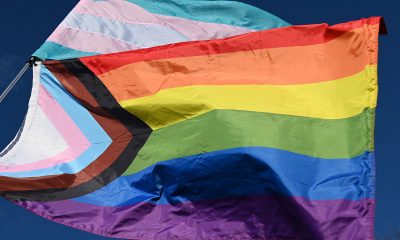
 California2 days ago
California2 days agoHate crimes targeting transgender and gender nonconforming people have tripled since 2013
-

 Books4 days ago
Books4 days ago‘Dogs of Venice’ looks at love lost and rediscovered
-

 a&e features3 days ago
a&e features3 days agoAllison Reese’s advice? Take your comedic medicine.
-
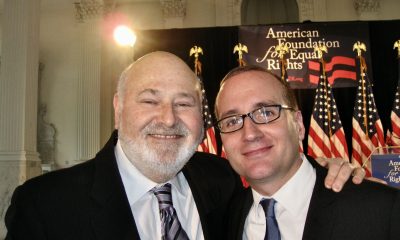
 COMMENTARY1 day ago
COMMENTARY1 day agoWhy Rob Reiner’s murder hit this old lesbian hippie so hard
-
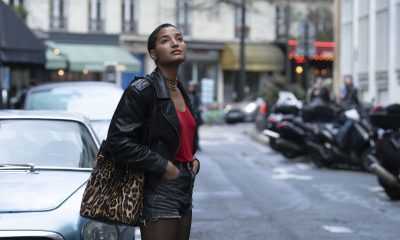
 a&e features1 day ago
a&e features1 day agoIndya Moore on history-making Gotham Award nomination and speaking out on social media: “It has complicated my access to work”
-

 Movies10 hours ago
Movies10 hours agoLong-awaited ‘Pillion’ surpasses the sexy buzz


